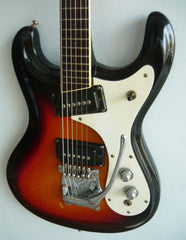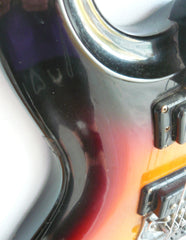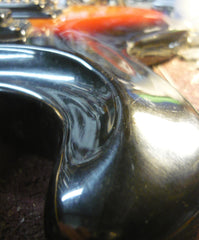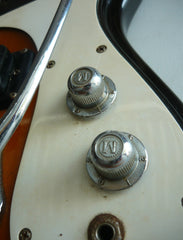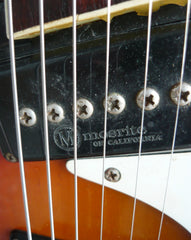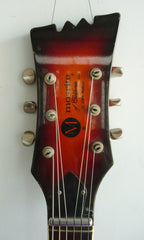1972 Mosrite Mk I
Share
It's no secret around here how obsessed I am with Mosrites. I recently started pulling them out of nooks and crannies around here and amazed myself with what I had. This isn't even all of them.

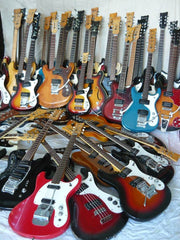
Yeah, I know ..............
I used to have a site dedicated to Mosrite info that I hope to put back up one day when I get time to collate and lay it out properly. Anyway, this one came in for some work and set up so I thought I'd share.

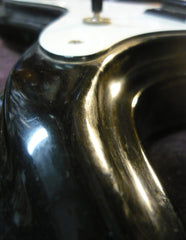

This one had an issue of the pick up "falling apart" which isn't uncommon on Mosrites. For all their greatness, they can be ........ temperamental, which is one of the things I love about them. Since this one's in pieces, and I used to make copies of them, here's a run down of the anatomy of a Mosrite pick up.

The typical (and most common) Mosrite pick up is the big single coil fitted to the Ventures style guitars from the very early 60's right through to the end of production (and beyond now) in the early 90's when Semie died. My old site covered all the different types and styles so I'll wait till I get that back online so as not to repeat myself. I'll just deal with this pick up which is essentially the same pick up fitted to an early 70's Mosrite Mark I (Ventures without the logo) guitar.

Because Mosrite made nearly everything "in house" the Mosrite pick up was pretty basic and utilitarian but to me, is one of the best pick ups ever made for any style. They are essentially similar to a P-90, my other favourite pick up, and often get mistaken for humbuckers because of their size. Mosrite made humbuckers in the same cover as well and they are spectacular HB's in my opinion. Slightly closer pole pieces than a "std" HB giving a more focused, clearer tone, kind of like a mini humbucker (also a great pick up) and Mosrite drilled right through the embossed logo on the cover for the pole pieces to poke through.
As you can see the Mosrite pick up is pretty industrial looking but it doesn't have to look pretty on the inside when it sounds this good. It is essentially, like most pick ups, a coil of fine wire, wrapped around a "bobbin" that holds the pole pieces (screws) resting on magnets. The pole pieces direct the magnetic flux into the string vibration and the coli generates a small electrical charge that gets sent to your amp. Simple.

This all looks pretty rough, but it's essentially all that is needed to make great tone. While being crudely assembled it works well and shows that modern assembly methods and state of the art manufacturing is not necessarily and advantage when it comes to that magic tone. You'll also notice there no "mojo" to be seen ............
Mosrite used simple segmented magnets literally "snapped" to the right length and glued to the bottom of the bobbin, that was maple offcuts from the necks cut roughly to size and drilled for the pole pieces to sit in. This whole assembly, with the coil was inserted into the cover with dental putty (like car filler) and set to dry. When the pick up isn't damaged from this it's just a simple case of glueing it back into place. I use epoxy for this.

Outputs vary from year to year and pick up to pick up but generally speaking they are HOT pick ups with outputs up to around 13K which is a lot of output for a single coil. I have Mosrites that will overdrive an amp straight from the pick up.
The thing I love about these pick ups is they're punch and clarity. It's the same thing I love about the P-90 and while these are similar, they have a tone all their own. Like a nice P-90, when you get that combination right with your set up, nothing comes close (for me) for most tones and styles.
Although these pick ups were crudely made, they (mostly) work beautifully. There's no wax potting, and yes, they can be microphonic and noisy but that's all part of R'n'R.
The thing to remember is, like with most vintage gear, there was no, or very little quality control back in the day and no-one back then thought anyone would be xraying and reverse engineering to a molecular level things like pick ups. They varied, sometimes dramatically, and no "brand" was exempt. Sure, vintage Gibson humbuckers or Fender single cols "look" more ......... professional, but they vary too. There's "clones" around now of most vintage gear that is better than "the average" original stuff out there. The best of the vintage is probably still "better" but the worst is MUCH worse and the best is out of the price range of most players now. Paying (literally) a tenth of the price for a modern approximation of a pick up (or pedal or ..........) from a reputable maker, to me, makes much more sense. They are "constantly" (and that's a very important word) better for the money.
Paying huge money for vintage gear now is a bigger gamble than taking your money down to the pokies. My advice when spending big on old gear ........... play it first. You're just as likely to be buying something someone is trying to get rid of because they bought it thinking it was going to be full of mojo and found it was full of something else.
Anyway, I digress. Here's some pics of one of the greatest shapes ever designed and made.



